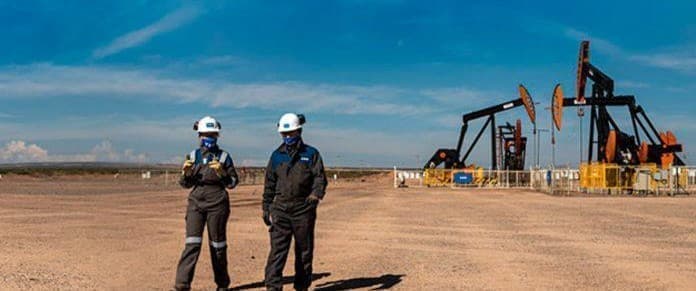Argentina’s booming Vaca Muerta shale play isn’t immune to the decline in oil prices and company spending this year.
Drilling activity is set for a near-term slowdown as foreign firms and the biggest domestic producer YPF SA are pulling out some frac crews amid lower international oil prices and a major asset reshuffle with mergers and acquisitions in recent months.
But the long-term prospects of the Vaca Muerta shale resources—one of the world’s biggest—remain intact, and Argentina is looking to monetize both the oil and gas production.
Vaca Muerta—Spanish for ‘dead cow’—has been dubbed the Argentinian Permian, although its geologic properties have been compared more appropriately to the Eagle Ford.
The shale play is estimated to hold recoverable resources consisting of 16 billion barrels of oil and 308 trillion cubic feet of natural gas. Those numbers make the Vaca Muerta the world’s second-largest shale gas deposit and the fourth-biggest shale oil resource.
In the first quarter of 2025, Vaca Muerta built on last year’s strong production performance, with oil output surging 26% and gas production rising 16% year-on-year, Rystad Energy has estimated.
Near-Term Slowdown
Production is rising, but the number of drilling rigs was down as of the end of July compared to the same time last year.
Some companies are pulling out rigs and crews amid reduced spending. As a result, drilling activity in Vaca Muerta is set for a near-term weakness, according to Horacio Marin, chief executive at Argentina’s oil and gas giant YPF.
“We might have to pull out a couple of fracking crews,” Marin said at an energy conference in Argentina, adding that this is “basically because of the slowdown we are seeing from international partners.”
However, the slowdown is part of a “new normal” for Argentina and Vaca Muerta, YPF’s top executive noted.
“We have to get used to a normal Argentina, where activity slows down a bit when the price of oil drops,” Marin said.
Five rigs out of operation in Vaca Muerta is not a cause for concern, he said, expressing optimism in the medium and long-term prospects of the shale play.
“Personally, I believe nothing can stop Vaca Muerta anymore,” Marin commented.
Related: Why Oil Prices May Be Stuck Below $72
Long-Term Boom
Currently, companies are responding to the lower oil prices and the consolidation drive that has seen several major deals in recent months.
In April, local independent firm Vista Energy bought the stake of Malaysia’s Petronas in the prolific La Amarga Chica (LACh) unconventional concession in Vaca Muerta.
This week, TotalEnergies announced the sale of its 45% operated interest in two unconventional oil and gas blocks in Vaca Muerta, Rincon La Ceniza and La Escalonada, to YPF for $500 million.
But TotalEnergies remains fully committed to Argentina, where it operates a large unconventional area of 183,000 net acres in Vaca Muerta.
Deals and other strategic positioning of foreign firms show that Argentina may have reversed its fortunes and become an attractive investment destination.
In a notable recent reversal, Norway’s Equinor – which had planned to exit the shale play – has reconsidered its earlier decision and will now remain in the region, Rystad Energy noted in June. The end of monetary restrictions in Argentina and the improvement in infrastructure and export viability have prompted Equinor to remain in Vaca Muerta.
“A shift in Equinor’s stance has marked something of a turning point, reaffirming international confidence in Argentina’s shale resurgence,” Rystad Energy said.
Despite the short-term slowdown, expectations for the longer term are that Argentina has finally entered a period of oil and gas production growth after years of waiting for Vaca Muerta to start paying off.
YPF’s Marin says the company “can develop all of Vaca Muerta” at oil prices as low as $45 per barrel.
The shale play can also deliver so much natural gas that it could make Argentina a major LNG exporter. But the country needs to build up infrastructure to ship the gas from supply centers to interstate regional pipelines and planned LNG export facilities. This could be made possible with continued reforms to attract foreign investment and reverse decades of investors shunning the country due to economic and fiscal instability.
Argentina has several LNG export projects in the works. YPF, for example, has signed agreements with international majors Shell and Eni to enter the project development of the Argentina LNG project, which includes gas production from Vaca Muerta gas blocks and its transportation through pipelines. These pipelines will extend 580 kilometers (360 miles) to a processing and liquefaction terminal to be built in Sierra Grande, Rio Negro, on the Atlantic coast.
Argentina has already taken a final investment decision (FID) on a floating liquefaction facility with a capacity of up to 2.5 million tonnes per annum (Mtpa). It is also evaluating an additional 3.5 Mtpa unit under the Southern Energy consortium consisting of Pan American Energy, Pampa, Harbour Energy, YPF, and Golar.
“Vaca Muerta’s strong oil gains are no surprise anymore as its track record speaks for itself. However, what we’re seeing now is that gas is stealing the spotlight,” says Radhika Bansal, vice president for Upstream Research at Rystad Energy.
“To leverage this momentum, the country is actively pursuing a bold, multi-phase national LNG export strategy, meaning Argentina could soon become a pivotal player in global gas supply, significantly reshaping markets and energy geopolitics.”
By Tsvetana Paraskova for Oilprice.com
More Top Reads From Oilprice.com
